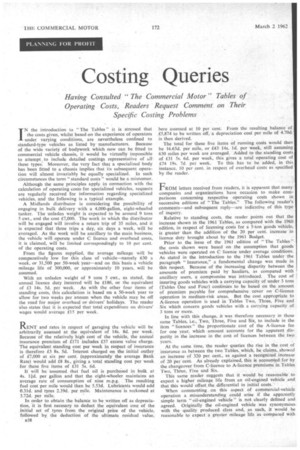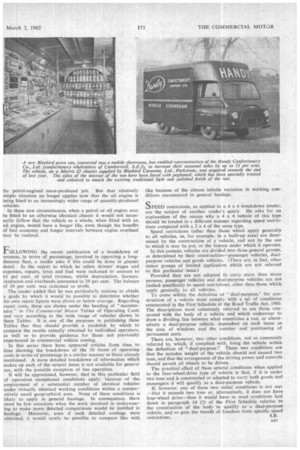Costing Queries
Page 102

Page 105

If you've noticed an error in this article please click here to report it so we can fix it.
Waving Consulted "The Commercial Motor" Tables of Operating Costs, Readers Request Comment on Their Specific Costing Problems
IN the introduction to "The Tables" it is stressed that the costs given, whilst based on the experience of operators under varying conditions, are nevertheless confined to standard-type vehicles as listed by • manufacturers. Because of the wide variety of bodywork which now can be fitted to commercial vehicle chassis, it would be virtually impossible to attempt to include detailed costings representative of all these types. Moreover, the very fact that a specialized body has been fitted to a chassis implies that its subsequent operation will almost invariably be equally specialized. In such circumstances the term "standard Costs" would be a misnomer.
Although the same principles apply in connection with the calculation of operating costs for specialized vehicles, requests are regularly received for information regarding specialized vehicles, and the following is a typical example.
A Midlands distributor is considering the possibility of engaging in bulk delivery with a 4,009-gallon, eight-wheeled tanker. The unladen weight is expected to be around 9 tons 5 cwt., and the cost £7,000. The work in which the distributor will be engaged will involve a return trip of 35 miles, and it is expected that three trips a day, six days a week, will be averaged. As the work will be ancillary to the main business, the vehicle will operate under C licence and overhead costs, it is claimed, will be limited correspondingly to 10 per cent. of the operating costs.
From the figures supplied, the average mileage will be comparatively low for this class of vehicle—namely 630 a week, or 31,500 per 50-week year—and on this basis a vehicle mileage life of 300,000, or approximately 10 years, will be assumed.
With an unladen weight of 9 tons 5 cwt., as stated, the annual licence duty incurred will be £186, or the equivalent of £3 14s. 5d. per week. As with the other four items of standing costs, this calculation is based on a 50-week year to allow for two weeks per annum when the vehicle may be off the road for major overhaul or drivers' holidays. The reader also states that it is expected that total expenditure on drivers' wages would average £15 per week.
RENT and rates in respect of garaging the vehicle will be arbitrarily assessed at the equivalent of 14s. 8d. per week. Because of the relatively high cost of the vehicle, the annual insurance premium of £171 includes £37 excess value charge. The equivalent standing cost per week in respect of insurance is therefore £3 8s. 5d, Interest charged on the initial outlay of £7,000 at six per cent. (approximately the average Bank Rate) would add £8 8s., giving a total standing cost per week for these five items of £31 5s. 6d.
It will be assumed that fuel oil is purchased in bulk at 45. ltd. per gallon and that the eight-wheeler maintains an average rate of consumption of nine m.p.g. The resulting fuel cost per mile would then be 5.53d. Lubricants would add 0.31d. and tyres 2.39d. per mile. Maintenance is reckoned at 3.72d. per mile.
In order to obtain the balance to be written off as depreciation, it is first necesary to deduct the equivalent cost of the initial set of tyres from the original price of the vehicle, followed by the deduction of the ultimate residual value, B38 here assessed at 10 per cent. From the resulting balance of £5,874 to be written off, a depreciation cost per mile of 4.70d. is then derived.
The total for these five items of running costs would then be 16.65d. per mile, or £43 14s. ld. per week, still assuming 630 miles per week are averaged. Added to the standing costs of £31 5s. 6d. per week, this gives a total operating cost of £74 19s. 7d. per week. To this has to be added, in this instance. 10 per cent, in respect of overhead costs as specified by the reader.
FROM letters received from readers, it is apparent that many companies and organizations have occasion to make comparisons concerning respective operating costs shown in successive editions of "The Tables." The following reader's comments—and subsequent reply—are indicative of this type of inquiry.
Relative to standing costs, the reader points out that the increase shown in the 1961 Tables, as compared with the 1960 edition, in respect of licensing costs for a 5-ton 'goods vehicle, is greater than the addition of the 20 per cent, increase in licence duty brought about by the 1961 Budget.
Prior to the issue of the 1961 edition of "The Tables" the costs shown were based on the assumption that goods vehicles were operated on C licence under average conditions. As stated in the introduction to the 1961 Tables under the paragraph "Insurance," a fundamental change was made in this respect. Because of the increasing disparity between the amounts of premium paid by hauliers, as compared with ancillary users, a compromise was introduced. The cost of insuring goods vehicles with a carrying capacity of under 3 tons (Tables One and Four) continues to be based on the amount of premium payable for comprehensive cover on C-licence operation in medium-risk areas. But the cost appropriate to A-licence operation is used in Tables Two, Three, Five and Six which concern goods vehicles with a carrying capacity of 3 tons or more.
In line with this change, it was therefore necessary in these same Tables, i.e:, Two, Three, Five and Six, to include in the item "licences" the proportionate cost of the A-licence fee for one year, which amount accounts for the apparent disparity in the increase in the cost of 'licences between the two years.
At the same time, the reader queries the rise in the cost of insurance as between the two Tables, which, he claims, showed an increase of 320 per cent., as against a recognized increase of 20 per cent. As already explained, this is accounted for by the changeover from C-licence to A-licence premiums in Tables Two, Three, Five and Six.
This same reader suggests that it would be reasonable to expect a higher mileage life from an oil-engined vehicle and that this would offset the differential in initial costs.
When commenting on this aspect of commercial-vehicle operation a misunderstanding could arise if the apparently simple term " oil-engined vehicle" is not clearly defined and agreed. Originally the oil-engined vehicle was synonymous with the quality produced class and, as such, it would be reasonable to expect' a greater mileage life as compared with
the petrol-engined mass-produced job. But that relatively drnple situation no longer applies now that the oil engine is being fitted to an increasingly wider range of quantity-produced vehicles.
In these new circumstances, when a petrol or oil engine may be fitted to an otherwise identical chassis it would not necessarily follow that the vehicle as a whole, when fitted with an oil engine, would have a longer life, even though the benefits of fuel economy and longer intervals between engine overhaul may be realized.
FOLLOWING the recent publication of a breakdown of revenue, in terms of percentage, involved in operating a longdistance fleet, a reader asks if this could be done in greater detail. In the report to which he refers drivers' wages and expenses, repairs, tyres and fuel were reckoned to amount to 61 per cent. of total revenue, whilst depreciation, licences, insurance and overheads amounted to 29 per cent. The balance of 10 per cent. was reckoned as profit_
The reader added that he was particularly anxious to obtain a guide by which it would be possible to determine whether his own repair figures were above or below average. Regarding repair costs, these are shown under the heading of " maintenance " in The Commercial Motor Tables of Operating Costs and vary according to the wide range of vehicles shown in these Tables. It is one of the purposes in publishing these Tables that they should provide a yardstick by which to compare the results actually obtained by individual operators, as well as to provide guidance for those not previously experienced in commercial vehicle costing.
In this series there have appeared articles from time to time showing the breakdown of the 10 items of operating costs in terms of percentage in a similar manner to those already mentioned. A more detailed breakdown of information which makes up each of the several items is not available for general use, with the possible exception of bus operation.
It will be appreciated, however, that in this particular field of operation exceptional conditions apply, because of the employment of a substantial number of identical vehicles under virtually identical working conditions within a comparatively small geographical area. None of these conditions is likely to apply in general haulage. In consequence, there must be few occasions when the work involved in endeavouring to make more detailed comparisons would be justified in haulage: Moreover, even if such detailed castings were obtained, it would rarely be possible to compare like with like because of the almost infinite variation in working conditions encountered in general haulage.
SPEED restrictions, as applied to a 4 x 4 breakdown tender, arc the subject of another reader's query. He asks for an explanation of the reason why a 4 x 4 vehicle of this type should be treated in a different manner regarding speed restrictions compared with a 2 x 4 of the same type.
Speed testrictions (other than those which apply generally to all vehicles, as, for example, in a built-up area) are determined by the construction of a vehicle, and not by the use to which it may be put, or the licence under which it operates.
In this context, vehicles are divided into three general groups, as determined by their construction—passenger vehicles, dualpurpose vehicles and goods vehicles. (There are, in fact, other minor groups of limited application which are not relevant to this particular-issue.)
Provided they are not adapted to carry more than seven persons, passenger vehicles and dual-purpose vehicles are not limited specifically to speed restrictions, other than those which apply generally to all vehicles.
To come within the definition of "dual-purpose," the construction of a vehicle must comply with a set of conditions enumerated in the First Schedule of the Road Traffic Act, 1960. The descriptions most commonly referred to are those concerned with the body of a vehicle and which endeavour to draw a dividing line between what constitutes a van, or alternatively a dual-purpose vehicle, dependent on such items as the area of windows and the number and positioning of permanent seats.
There are, however, two other conditions, not so commonly referred to, which, if complied with, bring the vehicle within the definition of "dual-purpose." These two conditions are that the unladen weight of the vehicle should not exceed two tons, and that the arrangement of the driving power and controls should permit all wheels to be driven. The practical effect of these several conditions when applied to the four-wheel-drive type of vehicle is that, if it is under two tons and is constructed or adapted to carry both goods and passengers it will qualify as a dual-purpose vehicle. If, however, one of these two initial conditions is not met --that it exceeds two tons or, alternatively, it does not have four-wheel drive—then it would have to meet conditions laid down in paragraph 14 (2) of the First Schedule relative to the construction of the body to qualify as a dual-purpose vehicle, and so gain the benefit of freedom from specific speed restrictions. S.B.




















































































































































